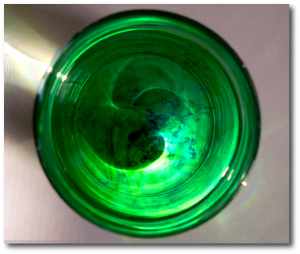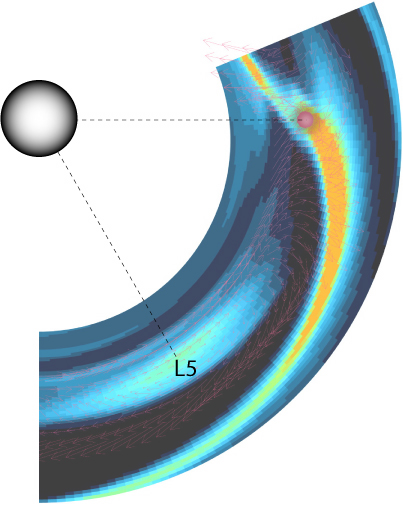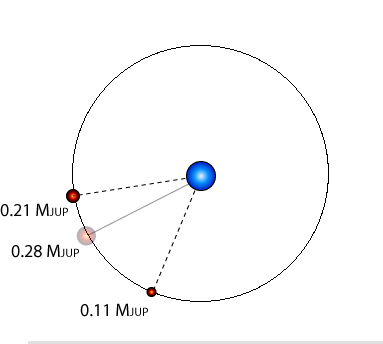
Image Source.
UCSC just put out a press release on the Systemic Project, so if you’re a first-time visitor to oklo.org, welcome aboard. You’ll find information about the project in the list of page links just to the right.
Last week, during my visit to Harvard CfA, I talked to Eric Ford, who has been exploring the idea of searching for trojan companions to extrasolar planets. He pointed out that the discovery of a body in a trojan configuration with a known extrasolar planet would provide an important test of theories of hot Jupiter formation. Here’s a link to his paper.
One way to make a hot Jupiter is to form the planet through the standard core-accretion method at a large radius in the protostellar disk. In this scenario, a newborn gas giant planet starts as a core of rock and ice, which grows to a size of 5-10 Earth masses and begins to rapidly accrete gas from the surrounding nebula. As the planet increases in size, it begins to clear a annular gap in the parent disk. Hydrodynamical simulations (such as the ones reported here, and reproduced in the illustration below) show that L4 and L5, the so-called trojan points located 60 degrees ahead and 60 degrees behind the forming planet, are the last regions of the gap to be cleared out.

It’s possible that co-orbital planets can form from the slow-to-clear material at L4 and L5. When the gas is gone, these objects will remain in stable trojan orbits.
If a pair of planets is caught in a trojan configuration, then they will migrate inward together through the disk, and the migration process will not cause them to become dynamically unstable. Eric points out that the observed presence of a trojan companion to a hot Jupiter would thus be evidence that the hot Jupiter arrived at its short-period orbit via migration. Other possibilities for forming hot Jupiters, such as dynamical instability followed by orbital circularization, do not allow for trojan companions.
A trojan pair of planets presents an interesting conundrum for planet hunters. Normally, a single planet on a circular orbit goes through its radial velocity zero point at the moment when the planet lies on the plane containing the line of sight from the Earth to the parent star. If we have a trojan, however, a planetary transit will be offset from the radial velocity zero point, which is associated with the orbit of a “ghost body” that combines the gravitational effect of the primary planet and its trojan companion. Using the console, try obtaining a two-planet perfect trojan (60 degree separation) fit to a well-known hot Jupiter data set such as that for HD 187123. You’ll find that it’s perfectly possible. The resulting configurations have utterly indistinguishable radial velocity signatures.

Trojans can be detected, however, if the primary planet happens to transit. The presence of the trojan companion can be inferred by measuring the lag between the center of the transit and the zero crossing of the radial velocity curve. For planets with an equal mass ratio, this would amount to a full 1/12 of an orbital period (6 hours for a 3-day orbit).
Which brings up an interesting project for transitsearch.org observers. Most of the known hot Jupiters have been checked photometrically for transits. These transit searches, however, are performed in the time window surrounding the radial velocity zero point. In the (admittedly unlikely) case that some of these objects are trojan pairs with near-equal mass ratios, the transits would have been missed using this approach. To fully rule out transits, one should cover the full 1/6th of an orbital period surrounding the nominal predicted transit time…

Hi Greg,
Is it reasonable to expect that if something forms at L4 or L5 in the same orbit as a Jovian, that the Trojan planet(s) are likely to be smaller — rocky?
I thought of that question after remembering your argument about M stars as places to look for habitable planets. Are any of the Jovians found thus far in these systems in a habitable orbit — habitable in the liquid water sense for their hypothetical smalller Trojan companions?
wb.
Hi Wb,
Good question. I think that because of the essentially threshold nature of Jovian planet formation, you’re much more likely to have L4 or L5 companions winding up much smaller than the primary.
Among the fourteen known transiting planets, there are clearly no Jovian-mass trojan companions, so it’s at least clear that near-equal mass trojan ratios are not the usual mode of formation for hot Jupiters.
Using Ford’s timing approach, we will soon have good limits on Earth-mass trojan companions to transiting giant planets.
best,
Greg
Hi Wb,
To address your second question… Yes, astronomers have discovered some giant planets that spend much or some of their time in the “habitable zone”. Unfortunately, none of those have been observed to transit.
As you point out, transit searches have a good chance of some day finding a large transiting planet in the “habitable zone” of an M dwarf. Then we could search for a rocky habitable Trojan with this technique.
BTW, in my paper we state,
“In principle, our technique could be applied to search for terrestrial-mass
Trojans of giant planets orbiting in the habitable zone of their stars
(Schwarz et al. 2005). While present search techniques are strongly
biased towards finding transiting planets at short orbital periods,
future space missions (e.g., Corot, Kepler) offer the prospect of
finding transiting planets in the habitable zone of their stars,
particularly for low mass stars where the habitable zone can be
~0.015AU away from the star.”
Regards,
Eric